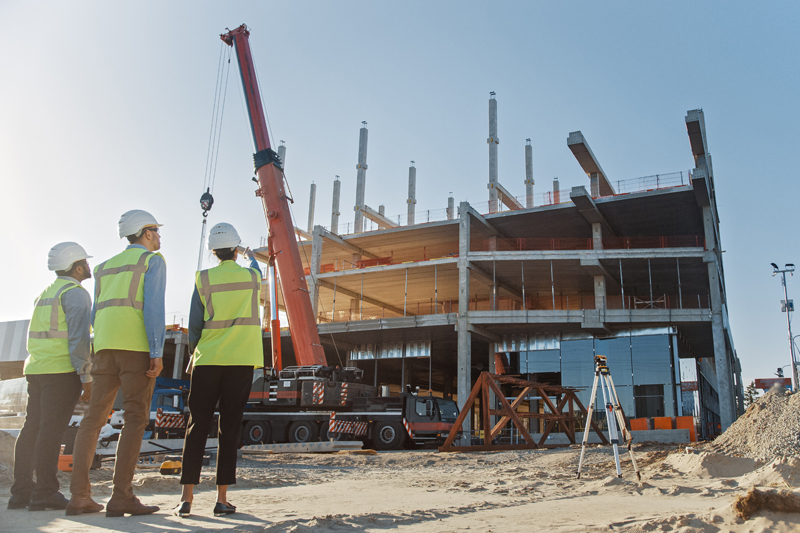
This article from NICEIC will look at the environmental factors that should be considered when selecting, installing and using electrical supplies and equipment on a construction site.
Most construction sites require electrical supplies to provide power for tools, equipment, lighting, and the like. The adverse environmental conditions typically found on construction sites inherently increase:
● the risk of damage occurring to wiring systems, electrical equipment, and
● the shock risk.
These increased risks need to be managed in order to comply with legislative requirements for construction site safety and for the use of electricity.
Environmental factors
The degree of risk and likelihood of damage to installed equipment, and as a result the persons using it, vary across a typical construction site. Therefore, the supply to electrical equipment must be suitable for the environment in which it is to be used, taking into account that electrical equipment will be operated by ordinary persons (as defined in Part 2 of BS 7671).
With the exception of the installations in administrative locations such as offices, meeting rooms and site welfare areas, where the general requirements of Parts 1 to 6 apply (704.1.1), electrical equipment used on a construction site must be suitable for the harsh conditions expected for the environment (704.512.2), including:
● contact with corrosive substances,
● ingress of liquids or dust and other solids,
● wear and tear caused in use by impact, abrasion, tension and flexing,
● extreme temperature fluctuations,
● damage by movement of vehicles and structures.

Measures to minimise likely detrimental effects
Wherever possible, electrical equipment and wiring systems should be located in a manner that minimises the chance of exposure to corrosive or polluting substances such as water, cement and/or plaster. One of the most effective ways of achieving this is by avoiding the installation of cables and/or equipment in locations where such exposure is likely.
However, where this is not possible, parts of the wiring system likely to be exposed to these detrimental substances should be suitably protected by additional mechanical protection or constructed of corrosion resistant materials (522.5.1).
Work on construction sites generally takes place outdoors and in all weathers. However, section 704 of BS 7671 does not state a minimum acceptable degree of ingress protection against either water, other liquids or foreign solid bodies, therefore the general rules given in Section 522 of BS 7671 will apply. For example, where water collects inside a wiring system, provision should be made for its escape, typically at the lower points within an accessory or containment system (522.3.2).
However, Section 704 does specify that:
All assemblies for the distribution of electricity on-site shall be in compliance with the requirements of BS EN 61439-4 (704.511.1). Clause 8.2.2 of this standard requires a minimum degree of ingress protection of:
● IP44 when all doors are closed and all cover plates and removable panels are in place
● IP21 provided that the door can be closed under all conditions of use, or IP44 at the operating face where the door cannot be closed.
Any plug or socket-outlet with a rated current of 16 A up to 125 A should comply with the requirements of BS EN 60309-2. Similarly, plug and socket-outlets with a rated current exceeding 125 A up to 800 A, and where interchangeability is not required, should comply the requirements of BS EN 60309-1 (704.511.1).
To avoid damage, cables should not be installed across site roadways or access ways used for transport and mobile plant. Where this is unavoidable, adequate mechanical protection shall be provided to minimise damage or potential deterioration caused by vehicles and the movement of building materials on-site (704.522.8.101), see Fig 2.

Alternatively, where it is necessary to route cables underground in such locations exposed to site traffic, cables should be laid in ducts at a depth of at least 0.6 m below finished ground level and a cable marker should be installed at each end of each road crossing (Clause 7.1.5 of BS 7375).
Additionally, cables run on the surface and/or overhead should be protected against mechanical damage, whilst taking into account the environment and likely activities at the construction site (704.522.8.101).
As with any other type of installation, the general rules of Chapters 51 and 52 of BS 7671 relating to effective selection and erection of equipment apply.
Where the protective measure of electrical separation of circuits is used in such locations, including for circuits supplying a socket-outlet with a rated current up to and including 32 A, and for any other circuit supplying hand-held electrical equipment, the requirements of Section 413 must be met (704.410.3.10). In particular, any flexible cables should remain visible throughout any part of their length liable to mechanical damage (413.3.4).
Only low temperature 3182/3/4/5A thermoplastic cable complying with BS 6004 or other equivalent flexible cable may be used for a reduced low voltage system (704.522.8.11).
Electrical equipment installed on a construction site must be suitable for the temperatures to which it might reasonably be expected to be exposed. Temperatures can fluctuate widely, especially when undertaking work in an open structure (Fig 1), leaving equipment vulnerable and exposed to the environmental elements over a range of seasons.
As required by Regulation 522.1.2, cables and associated wiring accessories should not be installed or manipulated outside of the boundary temperatures specified in the relevant product standard or in manufacturers’ data.
Table C.2 in Annex C of BS 6004 states that type 3182/3/4/5A round flexible cables are suitable for intermittent and temporary periods of short duration outdoor use, are resistant to frequent flexing and torsion, and may be both installed and handled at temperatures as low as -25 °C.
However Table C.3 of that standard clarifies that type 3182/3/4/5A cables are not suitable for outdoor use at voltages greater than 110 V. For applications exceeding reduced low voltage (RLV), flexible cable complying with H07RN-F (BS EN 50525-2-21) type or equivalent heavy duty flexible cable should be used (704.522.8.11).
Similarly, all flexible cables that are subject to movement on construction sites shall be H07RN-F type or equivalent (704.522.8.101). Such cables are generally manufactured with a polychloroprene sheath, giving them the capacity to resist abrasion and water. They have an operating temperature in the region of -15 °C to +60 °C when used in applications such as construction sites where frequent mounting and flexing is likely.
The flexible leads supplying power tools and other portable equipment on-site are particularly vulnerable to damage. As such, they should be checked before use to confirm their continued adequacy. As with any other cables, additional protection should be provided across routes where personnel or vehicular movement is expected.
Inspection and testing
Regular inspection and testing is essential to confirm the continued suitability of the temporary electrical installation, including the tools and equipment connected to it.
Clause 9 of BS 7375 recommends that:
Fixed installations, whether operating at 400/230 V or 110 V RLV, should be inspected and tested at least every three months but more frequently where necessary. Records should be kept of any test results obtained for future reference when determining whether deterioration has taken place.
Movable installations should be inspected and tested more frequently, typically weekly, or more often where conditions require it.
RCDs should be subjected to testing using an RCD test instrument every three months and it should be confirmed that pressing the integral test button causes the RCD to operate prior to operation of the equipment it protects.
Summary
A construction site can be a harsh environment for an electrical installation. So that the installation may be used safely by electrically unskilled persons, care must be taken when selecting equipment for use in such environments. Any chosen equipment must be suitably resilient to the potential sources of damage likely to be present, either by its construction or through the application of additional protective measures.
Get more details about NICEIC registration here








